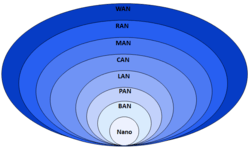Personal area network
| Computer network types by spatial scope |
|---|
 |
A personal area network (PAN) is a computer network for interconnecting devices centered on an individual person's workspace. A PAN provides data transmission amongst devices such as computers, smartphones, tablets and personal digital assistants. PANs can be used for communication amongst the personal devices themselves, or for connecting to a higher level network and the Internet (an uplink) where one master device takes up the role as gateway. A PAN may be carried over wired computer buses such as USB.
A wireless personal area network (WPAN) is a low-powered PAN carried over a short-distance wireless network technology such as IrDA, Wireless USB, Bluetooth and ZigBee. The reach of a WPAN varies from a few centimeters to a few meters.
Wireless personal area network
A wireless personal area network (WPAN) is a personal area network in which the connections are wireless. IEEE 802.15 has produced standards for several types of PANs operating in the ISM band including Bluetooth. The Infrared Data Association has produced standards for WPANs which operate using infrared communications.
Bluetooth
Bluetooth uses short-range radio waves. While historically covering shorter distances associated with a PAN, the Bluetooth 5 standard, Bluetooth Mesh, have extended that range considerably[1]. Further, long range Bluetooth routers with augmented antenna arrays connect Bluetooth devices up to 1,000 feet[2]. Uses in a PAN include, for example, Bluetooth devices such as keyboards, pointing devices, audio head sets, printers may connect to personal digital assistants (PDAs), cell phones, or computers.
A Bluetooth PAN is also called a piconet (combination of the prefix "pico," meaning very small or one trillionth, and network), and is composed of up to 8 active devices in a master-slave relationship (a very large number of devices can be connected in "parked" mode). The first Bluetooth device in the piconet is the master, and all other devices are slaves that communicate with the master. A piconet typically has a range of 10 metres (33 ft), although ranges of up to 100 metres (330 ft) can be reached under ideal circumstances. With Bluetooth mesh networking the range and number of devices is extended by relaying information from one to another. Such a network doesn't have a master device and may or may not be treated as a PAN.
Infrared Data Association
Infrared Data Association (IrDA) uses infrared light, which has a frequency below the human eye's sensitivity. Infrared in general is used, for instance, in TV remotes. Typical WPAN devices that use IrDA include printers, keyboards, and other serial communication interfaces.[3]
See also
- 6LoWPAN
- Ambient networks
- DASH7
- IEEE 802.15
- Internalnet
- RuBee
- Ultra-wideband and FM-UWB networks
- Wireless ad hoc network (WANET)
- Z-Wave
- ZigBee
References
- ↑ https://www.digitaltrends.com/mobile/bluetooth-5-release-news/
- ↑ http://www.ioti.com/infrastructure/cassia-networks-secures-patent-long-range-bluetooth
- ↑ Charles D. Knutson with Jeffrey M. Brown, IrDA Principles and Protocols, 2004, ISBN 0-9753892-0-3